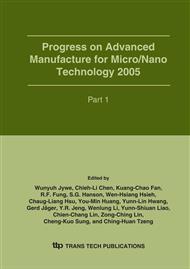p.745
p.751
p.757
p.763
p.769
p.775
p.781
p.787
p.793
Predictions of the Minimum Amounts of Preforming in the Radial Extrusion of Tubular Components
Abstract:
Both the minimum relative depth of die cavity and the minimum amount required in preforming are determined to produce a defect-free product of tubular component in the preforming technique of radial extrusion in this study. This scheme is based on the least amount of material dissipation in radial extrusion of tubular component. A finite element based code is utilized to investigate the effects of various relative depths of die cavity, different percentage of preforming and relative height reduction on the material flow characteristics resulting in the movements of the defects locations. The abductive network is also applied to synthesize the data sets obtained from the numerical simulations. Consequently, a prediction model is established for organizing the minimum relative depth of die cavity and the related minimum amount required in preforming of the tubular component for different end strokes of deformation.
Info:
Periodical:
Pages:
769-774
Citation:
Online since:
January 2006
Authors:
Price:
Сopyright:
© 2006 Trans Tech Publications Ltd. All Rights Reserved
Share:
Citation:


